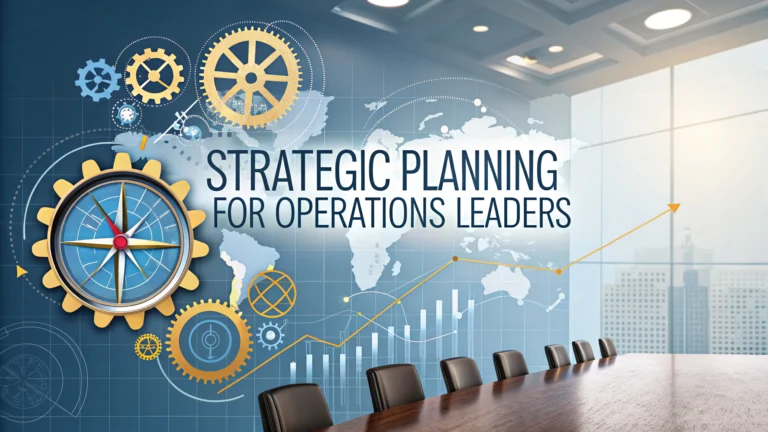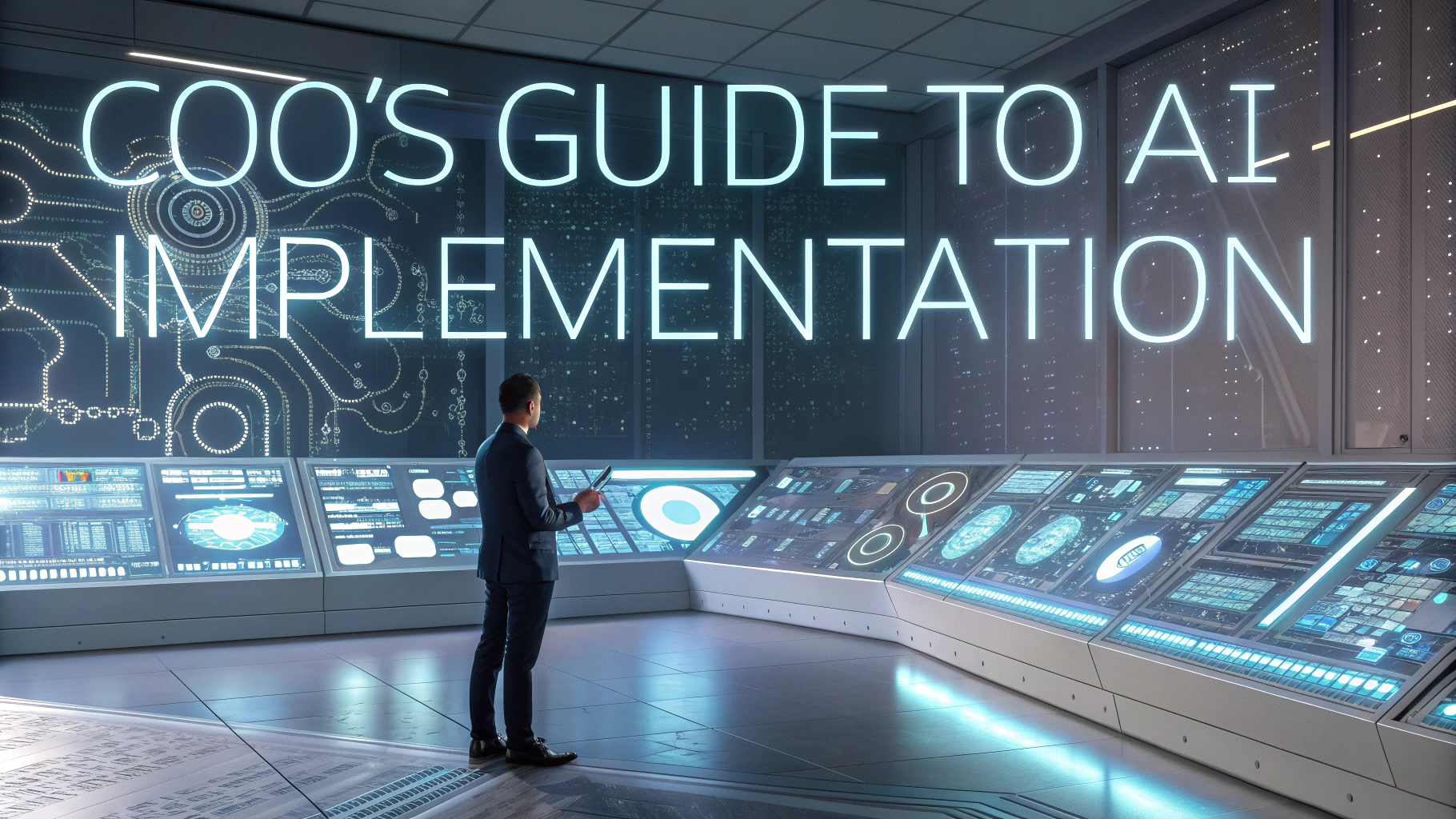Strategic planning establishes the roadmap for operational excellence and sustainable growth in organizations.
As a COO or operations leader, your strategic planning skills directly impact the company’s ability to execute its vision and achieve measurable results.
This guide covers proven approaches to strategic planning, specifically designed for operations leaders who need to balance long-term objectives with day-to-day operational demands.
Key Components of Strategic Planning
- Mission and vision alignment
- SWOT analysis focused on operations
- Resource allocation strategies
- Performance metrics and KPIs
- Risk assessment and mitigation
Setting Operational Objectives
Align departmental goals with broader organizational objectives using the SMART framework (Specific, Measurable, Achievable, Relevant, Time-bound).
Sample Operational Objectives:
- Reduce production costs by 15% within 12 months
- Improve customer satisfaction scores from 85% to 92% by Q4
- Decrease employee turnover by 20% in the next fiscal year
Resource Optimization Strategies
Effective resource allocation requires balancing human capital, technology, and financial resources.
Key Focus Areas:
- Workforce planning and development
- Technology infrastructure assessment
- Budget optimization and cost control
- Supply chain efficiency
Implementation Timeline
| Phase | Duration | Key Activities |
|---|---|---|
| Planning | 4-6 weeks | Strategy development, stakeholder alignment |
| Implementation | 3-6 months | Resource allocation, process changes |
| Review | Monthly | Performance tracking, adjustments |
Measuring Success
Track progress using a balanced scorecard approach that includes financial, customer, internal process, and learning/growth metrics.
Essential KPIs:
- Operational efficiency ratios
- Customer satisfaction metrics
- Employee engagement scores
- Financial performance indicators
Risk Management Integration
Incorporate risk assessment into strategic planning through regular evaluation and mitigation strategies.
Common Operational Risks:
- Supply chain disruptions
- Technology obsolescence
- Workforce challenges
- Regulatory changes
Tools and Resources
Leverage these strategic planning tools:
- Software: Oracle NetSuite, SAP Strategic Enterprise Management
- Frameworks: Balanced Scorecard, OKRs (Objectives and Key Results)
- Consulting: Big Four firms (Deloitte, PwC, EY, KPMG)
Moving Forward with Your Strategic Plan
Review and update your strategic plan quarterly to ensure alignment with changing business conditions and emerging opportunities.
Contact professional organizations like the Association for Strategic Planning (www.strategyplus.org) for additional resources and networking opportunities.
Communication and Change Management
Strategic plans require effective communication across all organizational levels to ensure successful implementation and buy-in from stakeholders.
Communication Strategies:
- Regular town halls and team meetings
- Progress dashboards and reports
- Digital communication platforms
- Feedback mechanisms
Cross-Functional Collaboration
Strengthen operational effectiveness through structured collaboration between departments and teams.
Key Integration Points:
- Sales and Operations Planning (S&OP)
- IT and Process Improvement
- HR and Workforce Development
- Finance and Resource Allocation
Continuous Improvement Framework
Implement systematic approaches to identify and execute operational improvements.
Improvement Methodologies:
- Lean Six Sigma principles
- Kaizen events
- Agile methodologies
- Quality management systems
Driving Strategic Success Through Operational Excellence
Transform strategic planning from a periodic exercise into an ongoing process that drives operational excellence and sustainable growth. Regular review cycles, stakeholder engagement, and adaptive planning ensure your organization remains agile and competitive in an evolving business landscape.
Critical Success Factors:
- Leadership commitment and visibility
- Clear accountability and ownership
- Data-driven decision making
- Continuous learning and adaptation
FAQs
1. What are the key components of a successful strategic operations plan?
Clear objectives, resource allocation, performance metrics, risk assessment, timeline development, stakeholder alignment, operational efficiency targets, and implementation roadmap.
2. How often should operations leaders review and update their strategic plans?
Strategic plans should be reviewed quarterly for progress and adjusted annually, with major revisions every 3-5 years or when significant market changes occur.
3. What role does technology play in modern operations strategy?
Technology enables process automation, data analytics for decision-making, supply chain optimization, resource management, real-time monitoring, and improved customer service delivery.
4. How do operations leaders effectively balance cost reduction with quality maintenance?
Through lean management principles, process optimization, strategic sourcing, automation of repetitive tasks, quality control systems, and continuous improvement programs.
5. What metrics should operations leaders track to measure strategic success?
Key metrics include operational efficiency, cost per unit, cycle time, customer satisfaction scores, employee productivity, inventory turnover, quality metrics, and return on investment (ROI).
6. How can operations leaders ensure successful strategy implementation across different departments?
Through clear communication channels, stakeholder buy-in, defined responsibilities, regular progress meetings, performance tracking, and change management protocols.
7. What risk management strategies should be included in operational planning?
Supply chain diversification, business continuity planning, compliance monitoring, disaster recovery protocols, cybersecurity measures, and financial risk assessment.
8. How do operations leaders align strategic planning with organizational growth?
By developing scalable processes, planning for capacity expansion, identifying growth bottlenecks, maintaining flexibility in resource allocation, and ensuring infrastructure readiness.
9. What role does workforce planning play in operations strategy?
Workforce planning ensures proper staffing levels, skills development, succession planning, talent retention, and alignment of human resources with operational objectives.
10. How should operations leaders approach digital transformation initiatives?
Through systematic assessment of current processes, identification of automation opportunities, ROI analysis of technology investments, phased implementation, and employee training programs.







